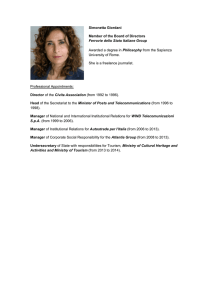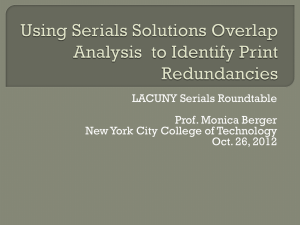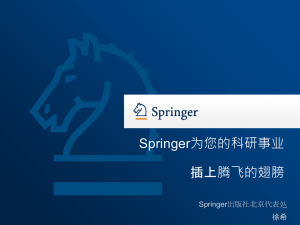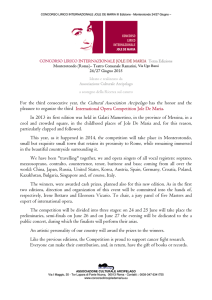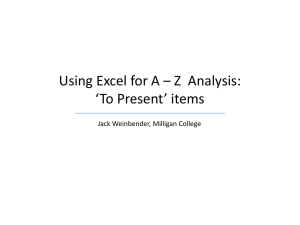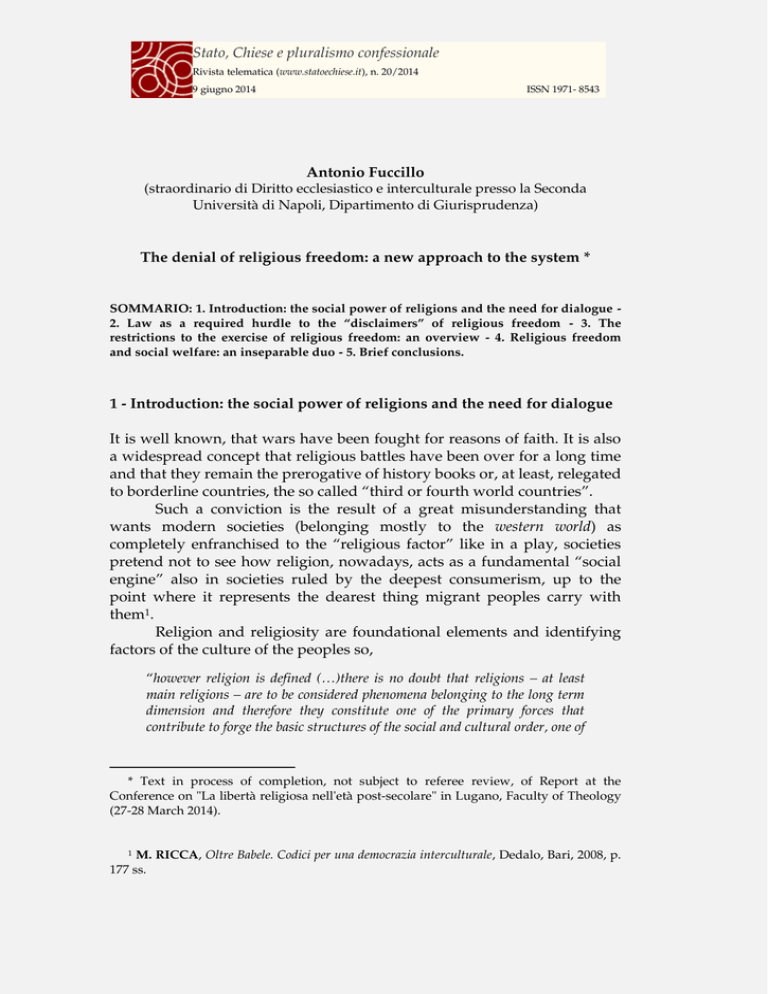
Stato, Chiese e pluralismo confessionale
Rivista telematica (www.statoechiese.it), n. 20/2014
9 giugno 2014
ISSN 1971- 8543
Antonio Fuccillo
(straordinario di Diritto ecclesiastico e interculturale presso la Seconda
Università di Napoli, Dipartimento di Giurisprudenza)
The denial of religious freedom: a new approach to the system *
SOMMARIO: 1. Introduction: the social power of religions and the need for dialogue 2. Law as a required hurdle to the “disclaimers” of religious freedom - 3. The
restrictions to the exercise of religious freedom: an overview - 4. Religious freedom
and social welfare: an inseparable duo - 5. Brief conclusions.
1 - Introduction: the social power of religions and the need for dialogue
It is well known, that wars have been fought for reasons of faith. It is also
a widespread concept that religious battles have been over for a long time
and that they remain the prerogative of history books or, at least, relegated
to borderline countries, the so called “third or fourth world countries”.
Such a conviction is the result of a great misunderstanding that
wants modern societies (belonging mostly to the western world) as
completely enfranchised to the “religious factor” like in a play, societies
pretend not to see how religion, nowadays, acts as a fundamental “social
engine” also in societies ruled by the deepest consumerism, up to the
point where it represents the dearest thing migrant peoples carry with
them1.
Religion and religiosity are foundational elements and identifying
factors of the culture of the peoples so,
“however religion is defined (…)there is no doubt that religions – at least
main religions – are to be considered phenomena belonging to the long term
dimension and therefore they constitute one of the primary forces that
contribute to forge the basic structures of the social and cultural order, one of
* Text in process of completion, not subject to referee review, of Report at the
Conference on "La libertà religiosa nell'età post-secolare" in Lugano, Faculty of Theology
(27-28 March 2014).
1 M. RICCA, Oltre Babele. Codici per una democrazia interculturale, Dedalo, Bari, 2008, p.
177 ss.
Stato, Chiese e pluralismo confessionale
Rivista telematica (www.statoechiese.it), n. 20/2014
9 giugno 2014
ISSN 1971- 8543
those arrays of sense that outline the face of a civilization and impress an
indelible mark on legal size-rules”2.
It cannot be denied how the religious factor has returned to be one of
the contemporary engines of society, on one side there is a strong element
of belonging and signification of the identity of the subjects, on the other
side as a moment of cultural diversity of individuals and peoples3.
Moreover, religion has always resumed its place in history. The “twilight
of the Gods has been postponed” as well as the forced distinction between
“matters of faith” and “political issues”, the religious passions have
returned, to condition peoples’ life and policy decisions4.
Therefore it is required to confront such reality and the needs of the
“peoples”, but it must be done in a way appropriate to the inter-religious
diversity (also inter-cultural diversity) of the social structure both national
and global.
In a journalistic essay of a few years ago5 the Authors observed how
the world was affected by conflicts related to other religions or inside
them and that conflicts can reveal themselves in various ways, by the
multiple representations of offensiveness (expressed in different forms
and ways), diverse form of social discrimination and violence. The extent
of the phenomenon is such that does not exclude the “non-believers”, who
on the one hand, have to live with the various religious faiths that are
clamoring for spaces of action always broader, on the other hand they
have always greater difficulties to assert their vision of the world,
especially in the countries that have legal systems strongly influenced by
denominational rights6.
The history is strongly bringing to the attention of politics and,
consequently, also to law as a science devoted to the achievement of the
“social peace” as regulation of civil coexistence, the religious factor as
S. FERLITO, Presentation to the volume of H.P. GLENN, Tradizioni giuridiche del
mondo. La sostenibilità della differenza, italian version, il Mulino, Bologna, 2010, p. XVII.
3 It is shown that the “confessional phenomena” may “be considered contained within
the phenomenon religion understood in cultural terms”, M. RICCA, Multi-religiosity,
multiculturalism, reactions of the sort. Three trail to the intercultural right, in ID., Dike meticcia.
Rotte di diritto interculturale, Rubbettino, Soveria Mannelli, 2008, p. 132.
4 See the extensive analysis (imbued with a critical sense) di M. LILLA, Il Dio nato
morto, Baldini Castoldi Dalai, Milano, 2009.
5 The work is inspired by the article One week of concrete commitment to interreligious peace in the world, of Tony BLAIR and of Prince GHAZI of Giordania, on the
newspaper Corriere della sera of the 13 January 2011, p. 48.
6 On “islam and politics” in the contemporary thought, see M. CAMPANINI, Il
pensiero islamico contemporaneo, il Mulino, Bologna, 2009, p. 129 ss.
2
2
Stato, Chiese e pluralismo confessionale
Rivista telematica (www.statoechiese.it), n. 20/2014
9 giugno 2014
ISSN 1971- 8543
defining element of all contemporary societies. The above mentioned
factor cannot be eliminated from legal texts, with a simple stroke of a pen
in regards to an alleged legal and layman moral that should govern the
world of law, but it has to be considered as one of the elements that
influence peoples actions both as individual (there is no reason to deny it)
and as a part of an institution.
The danger is hidden in the indifference towards the religious
phenomenon that, used as manifesto of laity, induces, as a direct
consequence, those who identify themselves in a faith to claim, sometimes
even with deplorable violence, its own space7.
The International political community seemed to formally realize
this when the UN General Assembly of the 20 October 2010 approved (34th
Plenary Assembly), with unanimous vote, a resolution designating the
first week of February of each year the World interfaith harmony week8. It
can be seen, with optimism, in such an initiative, a substantial aid to
overcome the mistrust based on religious diversity and the intention is
also commendably promoting the development and consequentially the
spread of an effective dialogue between the various churches, a true
ecumenism in part already positively present9.
The need to understand each other inevitably also shares an
assumption of what you want to hear, in legal terms, for the word
‘religion’ in any context. Therefore, even to characterize religion with
respect to the issues of persecution and discrimination, it has been
successfully proposed that there are three different methods to the
approach to religion itself, belief, identity or way of life 10. All useful criteria
for a correct approach to the problem.
The denial of religious freedom, therefore, is not a problem only of
the less-developed countries but also of those that claim to be bastions of
E. PACE, Perché le religioni scendono in guerra?, Laterza, Bari-Roma, 2004.
It is rightly pointed out that, in such resolution, God is expressly cited (rare
circumstance in a document of some normative valence), and propose a series of actions
aimed at the development of inter-religious dialogue between peoples, but also between
different believers and between them and the non-believers within each local reality. For
this purpose, however, it has been set up a special web-site (www.worldinterfaithharmony
week.com) where to make public documents, sermons, various initiative aimed at the
development of inter-religious dialogue and knowledge of the other.
9 A. FUCCILLO, Pace interreligiosa: alcuni spunti di riflessione a margine della World
interfaith harmony week ed il possibile ruolo del diritto, in Stato, Chiese e pluralismo
confessionale, Telematic Review (www.statoechiese.it), February 2011.
10 T.J. GUNN, The complexity of religion and the definition of “religion” in International
law, in Harvard Human Rights Journal, vol. 16, 2003.
7
8
3
Stato, Chiese e pluralismo confessionale
Rivista telematica (www.statoechiese.it), n. 20/2014
9 giugno 2014
ISSN 1971- 8543
democracy, when they do not allow all the people that are “different” the
same possibility of access to the tools of the economic and social welfare
and to the equal and related legal institutions, including the inevitable
legal problems related to intercultural communication11.
2 - Law as a required hurdle to the “disclaimers” of religious freedom
The world is never free from the religious conflicts, but we in the west
have transported them from the fields of battles and death, to the more
cunning and devious one of social discrimination.
However, a careful consideration of the delicate relationship
between “exercise of freedom of religion” and “inter-religious conflicts”
should be done, a combination that seems to be central also in those reports
that are directly involved in the problem.
In the “Rapporteur’s Digest on Freedom of Religion or Belief Excerpts of
the Reports from 1986 to 2011 by the Special Rapporteur on Freedom of
Religion or Belief Arranged by Topics of the Framework for
Communications12” UN “human rights” Office, emerging data of absolute
relevance that represents how the front of the “religious freedom” is
always open and proposes a miscellanea of varied situations that affect the
extremes of the war of religion that are still present in some countries and
the conflict between “fundamental rights” that are typical of the western
world13.
The prevailing criticality in terms of religious discrimination were
in fact highlighted as follows:
“Discrimination: Discrimination on the basis of religion or belief/interreligious discrimination/tolerance..State religion. Vulnerable groups :
Women – Persons deprived of their liberty – Refugees – Children –
Minorities – Migrant – Workers”
criticality which are obviously already known by the people who deal
professionally14 with such events.
M. RICCA, Intercultural Law, Interdisciplinary Outlines. Lawyering and Anthropological
Expertise in Migration Cases: Before the Courts, in www.eic.aiss.it (Telematic Review), n. 2,
2005.
12 http://www2.ohchr.org/english/issues/religion/.
13 On the assumption, of course, of the common recognition in such contexts such
legal claims situations.
14 Among the many The World Watch List of Open Doors International is probably the
11
4
Stato, Chiese e pluralismo confessionale
Rivista telematica (www.statoechiese.it), n. 20/2014
9 giugno 2014
ISSN 1971- 8543
The data seems to conflict with the content of the Declaration on the
Elimination of All Forms of Intolerance and of Discrimination Based on Religion
or Belief (Proclaimed by General Assembly resolution 36/55 of November
25, 1981).
Addressing the issue of the “denial of religious freedom in the
twenty-first century” is therefore a difficult task, since as just highlighted,
the criticality that emerge are several and linked to socio-cultural contexts,
as well as to the identity of the individual nation states. It is therefore
impossible to carry out a review which represents all the particular
realities but you can try to verify, from a “legal” point of view, how the
characterization of religious freedom taken as a “subjective right” can help
determine a possible hypothesis if not a solution, at least of a weakening
of religious conflicts.
The role of the law in this context, is clear, also to the super-national
institutions; the mentioned “report” of the UN, for example, after having
in more points stressed the centrality of the legal issues, says par.“115”15
that
“Internal protection. This will mean improving legal protection, in
particular under criminal legislation:(a) Each State should provide judicial
guarantees to ensure that freedom of religion or belief and membership of an
ethnic and religious group are protected in a concrete manner by explicit
provisions.
It would be desirable for some States to enact general legislation based on
international standards;
(b) States must make efforts to enact legislation or to modify existing
legislation, as appropriate, in order to prohibit all discrimination based on
identification of individuals with multiple groups. Most importantly,
positive criminal legislation should be enacted, not only imposing severe
penalties on single forms of discrimination, but above all defining a new
offence, that of aggravated racial and religious discrimination, which should
carry a specific penalty, and naturally one that is heavier than that imposed
for single forms of discrimination, whether religious or racial;
oldest of the measuring instruments (annual), still currently used to measure the indices
of religious freedom and religious persecution in the world. On the characteristics of the
new questionnaire of the World Watch List see C. SAUER, Measuring Persecution. The new
questionnaire design of the World Watch List, in International Journal of religious Freedom, vol.
5, 2012, p. 21 ss.
15 Rapporteur’s Digest on Freedom of Religion or Belief Excerpts of the Reports from 1986 to
2011 by the Special Rapporteur on Freedom of Religion or Belief Arranged by Topics of the
Framework for Communications, p. 51.
5
Stato, Chiese e pluralismo confessionale
Rivista telematica (www.statoechiese.it), n. 20/2014
9 giugno 2014
ISSN 1971- 8543
(c) Establishment of an independent equal opportunity authority to monitor
racial and religious discriminations”.
The interrelationship between law societies and the religious factor,
carry in the western world inter-religious tensions in the creation of
standards (through the lobbing prevailing groups perform with greater
effectiveness) and in the application of the same as the majorities occupy
with greater ease the seats of power of state bureaucracies. The sense of
“laity” of law tends to lose its way and without technical tools that are
effectively neutral, there is the risk to negatively distort the also effective
primary norms to guarantee an equal religious freedom.
In the Western world, therefore, social tensions arising from
religious differences tend to assume a shape less virulent but none the less
violent and more subtle that is, social discrimination. .The law is then
called to make an effort of activation and positivitation of “religious
freedom” trough an arrangement of “legal” answers that tend to the
elimination of discriminatory and persecution phenomena. In this
viewpoint, should be read then the UN useful remainder to the individual
state to set up a regulatory system that is based not only on the provision
of more and more effective criminal sanctions, but that protects every
form of religiosity regardless of the number of faithful in each single
territory through a greater harmonization in terms of the legal systems
involved.
3 - The restrictions to the exercise of religious freedom: an overview
The negative profile of religious freedom, or rather the obstacles that its
own expression encounters in many parts of the world, is the subject of
many analysis, historical, sociological, anthropological and statistics but it
does not seem to affect, in a decisive way the legal science scholars even if
important openings are starting to be recorded16.
The basic conceptual mistake that is often committed is to identify
the role of law in relation to repression of the criminal aspects that is, the
arrangement of punitive forms of religious freedom violations, almost
For example, in the last consultation organized by the International Institute for
religious freedom (Istanbul 16-18 march 2013) on which important event cf. International
Consultation on Religious freedom research, chronicle in Italian by G. CROCCO, in Diritto e
religioni, n. 15, 2013, p. 357 ss.
16
6
Stato, Chiese e pluralismo confessionale
Rivista telematica (www.statoechiese.it), n. 20/2014
9 giugno 2014
ISSN 1971- 8543
forgetting the assumption that it almost relegates the role of the criminal
aspects to extrema ratio among the legal remedies.
It should be noted, however, also to justify the prevailing demands
for better tools to criminal prosecution that, in many countries, the
religious freedom is far from being guaranteed. In many states, for
example, the faith of the majority of the population is imposed on
everyone and religious minorities have no right of expression and,
consequently, no legal protection.
The following graph17 is the result of an important survey
conducted by Pew Forum18 that has demonstrated how the
implementation of religious freedom encounters obstacles even in
countries that are allegedly liberal. Interesting is also the position of Italy
declared among the countries with s “moderate” social hostility in terms
of the expression of religious freedom19.
In this last regard, it is interesting to note how a recent research has
identified several critical issues within the Italian society between the
areas of greater social impact, where religions operate, by identifying in a
sociological sense “the absence of a policy of religious pluralism
recognized and shared as primary democratic theme”, defining Italy
religions as a “job site without a project”20. The absence of a direct
legislation to regulate the religious association and the co-existence of a
“common” law with a special right reserved to some religious confessions,
it constitutes the greater Italian criticality and it’s perhaps the main
obstacle to an expression of religious freedom equal for all21.
17 RELIGIOUS HOSTILITIES REACH SIX-YEAR HIGH, January 2014, of the Pew
Research Center, A. Cooperman, B.J. Grim, E. O’connell (ed.), www.pewforum.org.
18 Pew Research Center's Religion & Public Life Project, www.pewforum.org.
19 On the case Italia, see A. FERRARI, La libertà religiosa in Italia. Un percorso
incompiuto, Carocci, Roma, 2012; see also A. FERRARI, Civil religion in Italy: “A mission
impossibile?”, in The Gorge Washington International law Review, n. 41, 2010, p. 839 ss.
20 AA. VV., Un cantiere senza progetto. L’Italia delle religioni, rapporto 2012, ed. P. Naso
and B. Salvarani, Emi, Bologna, 2012; with particular reference to the Introduction, p. 17
ss.
21 In theme I would like to make a referral to A. FUCCILLO, L’attuazione privatistica
della libertà religiosa, Jovene, Napoli, 2005.
7
Stato, Chiese e pluralismo confessionale
Rivista telematica (www.statoechiese.it), n. 20/2014
9 giugno 2014
ISSN 1971- 8543
Even in the European context where it appears more than in other
areas asserted the laity nature of public institutions and, consequently, of
the law produced both by the individual states and Community
institutions and supra-national, there are some criticalities well
highlighted in the Handbook on European non-discrimination law where it is
reported a significant case of discrimination which involved Croatia 22.
In recent years, even within the context of the “Democracies
stabilized” the debate on the effective exercise of freedom of religion has
Handbook on European non-discrimination law: Case-law update July 2010-December 2011
edited by European Union Agency for Fundamental Rights, 2012 Council of Europe/European
Court of Human Rights, 2012Publication of the FRA - 2012. European Union Agency for
Fundamental Rights, 2012 Council of Europe / European Court of Human Rights, 2012,
p. 18 ss.
22
8
Stato, Chiese e pluralismo confessionale
Rivista telematica (www.statoechiese.it), n. 20/2014
9 giugno 2014
ISSN 1971- 8543
been accelerated due to the crisis of experiences (considered wrongly)
established “rules” of religious freedom.
So both societies are in crisis, the “confessionalist” society which
tends to favor one or a few religious faiths and those “separatist” which
favor a clear distinction between the State and religious confessions. In
contemporary societies the binomial , or, in some cases the dissociation,
State-religion, State-religious confessions, constitutes a genus of relations
to which different species respond to and that may in certain and extreme
areas lead to discriminatory and restrictive conduct as well as culturalreligious conflicts. The model traditionally applied to the individual
system enters into a state of crises as it is more and more “invaded” by
alien models among which, at least in Continental Europe, invests the
close encounter (clash) with Islam 23.
Also in other realities, defined as “separatist-hostile” systems, the
regulatory principles are in crisis because of the problematic issues
concerning the relations between “traditional” faiths and “cults” as for
example in France, in Russia e in Mexico, as well as the (de-)
confessionalism in Portugal, Spain and Quebec.
Stefano Ceccanti, for example, represents how the model of
religious freedom whose classification must remain unquestioned in the
catalogue of fundamental rights of man, should be flexible enough to
adapt to almost all the instances of all the new religious reality without
distortions. In the view of the same author, despite the experience of the
Catholic Church as the dominant confessional reality in Western societies
there is an uncertainty and traditionalistic defensive closure related to the
fears induced by the multi-ethnic society and to the difference between
ethics and the right to live in a more pluralist way, it does not seem to
crack the consensus around the model of religious freedom in the broadest
sense of its own (concrete) meaning 24.
The role of the law must therefore be increasingly valued in the
sense that it is responsible for the difficult task of certainly producing an
embankment to discriminatory and persecutory conducts also by
promoting laws that allow the exercise of freedom of religion.
Grim and Finke they in fact notice that
On the “Islamic dream” to conquer the West interesting ideas in C. POLLANZ, The
Legal Theory for Muslim Minorities and the Islamic Dream of conquering the West, in Journal of
the Institute of Islamic Studies, n. 2, 2012, VTR, Nürnberg, 2012, p. 18 ss.
24 S. CECCANTI, Una libertà comparata. Libertà religiosa, fondamentalismi e società
multietniche, il Mulino, Bologna, 2001.
23
9
Stato, Chiese e pluralismo confessionale
Rivista telematica (www.statoechiese.it), n. 20/2014
9 giugno 2014
ISSN 1971- 8543
“Religious restrictions – composed of social and government restrictions –
help explain violent religious persecution, which is a specific form of social
and civil conflict. We expect that when governments censure religious
freedom and equitable treatment for all religions, less persecution will result.
[…] But when government restrictions result in increased persecution (that
can often be interwoven with other social conflicts), this fuels even more calls
for restrictions to control minority religions. Thus, government clashes with
religion often justify a call for reduced religious freedoms, leading to more
clashes, and so the cycle continues”25.
In reference to the above reported graph26, the authors point out
that the religious homogeneity does not ensure freedom from conflicts. In
fact inside of it, it is demonstrated that 33% of the countries dominated by
one religion have a high level of persecution compared to 20% where there
is no dominant religion. Moreover, the authors show that “the danger of
despotism” becomes real when there is only one dominant religion instead
a plurality of faiths is always associated to “public peace”27.
The phenomenon is often caused by “the fear of different from us”
as it traditionally qualifies the common religious belief as one of the
identifying features of the “nation of people”28.
See B. GRIM, R. FINKE, The price of freedom denied. Religious persecution and conflict
in the 21st century, Cambridge University Press, 2011, p. 74.
26 See B. GRIM, R. FINKE, The price of freedom denied, cit., p. 67.
27 See B. GRIM, R. FINKE, The price of freedom denied, cit., p. 74.
28 M.C. NUSSBAUM, The new religious intolerance, translated from original to italian
edition: La nuova intolleranza, Il Saggiatore, Milano, 2012, p. 29 ss.
25
10
Stato, Chiese e pluralismo confessionale
Rivista telematica (www.statoechiese.it), n. 20/2014
9 giugno 2014
ISSN 1971- 8543
Martha Nussbaum is effectively explicit in stating that “to respect
the freedom of conscience in an equal manner implies that the state cannot
create a system of two-speed citizenship by establishing an orthodoxy that
dispenses rights to others unevenly”.
Consequently, in keeping with the American tradition and recalling
the conceptions of Williams and Madison, the freedom of conscience is
incompatible with any kind of religious institutionalization or atheist.
Even though the social fabric of the United States is not immune to social
religious tensions partly caused by the “religious phobia” and by the
presence in that social context of many and varied religious groups29.
Hence the author’s explicit invitation to extend to every country the liberal
and tolerant American tradition towards all faiths. A lesson also directed
to Italy: “a theory of political principles based on the idea of the human capacity
should learn from tradition (American, ed.) and reject both orthodoxism and antireligion in order to be completely respectful and fair to all human beings“30.
4 - Religious freedom and social welfare: an inseparable duo
The denial of religious freedom is then carried out in a particularly
effective way and therefore the same ferocious as it tends to affect the
dignity of people in their workplace and the access to economic
instruments, which usually results in a lowering of the quality of life of
those affected.
Belonging to religious minorities (even substantial) may affect the
exercise of their manual or intellectual work both in the access to the same
opportunities reserved for the “majorities” and in its concrete exercise.
That religion plays a central role in the dynamics of social
development is a well established concept31 and it is in this perspective
that can serve as an engine for economic development. Social
discrimination caused by different degrees of access to welfare often
results in different level of education and in general of “good life” that
favors, when very scarce, intolerance and in general discriminatory and
persecutory processes.
M.C. NUSSBAUM, The new religious intolerance, translated from original to italian
edition: La nuova intolleranza, cit., p. 23 ss., illustrating case studies of interest.
30 M.C. NUSSBAUM, Libertà di coscienza e religione, il Mulino, Bologna 2009, p. 88.
31 M. RICCA, Pantheon. Agenda della laicità interculturale, Torri del Vento, Palermo,
2012, p. 29.
29
11
Stato, Chiese e pluralismo confessionale
Rivista telematica (www.statoechiese.it), n. 20/2014
9 giugno 2014
ISSN 1971- 8543
Reducing the economic gap is therefore a useful tool to fight all the
persecutions that arise from the social embittering.
However, the level of “religious freedom” should be increased not
only with declaration of principle but with the assumption of specific legal
instruments to help this process.
Local traditions, in fact, are complemented by those imported and it
is no doubt that religions play a decisive role in this context, with the
effect of producing an encounter between different faiths that if not
governed by a legal system that is actually intercultural, can easily be
transformed in a clash.
Therefore, conditions must be created so that “foreigners and
minorities” have the right “to be recognized in the law and not only in
front of it”32. The exercise of “religious freedom” both of individuals and
groups resulting in behaviors that involve choices of belonging and faith,
is certainly in the position to influence the economic and legal systems, in
the sense that where this (religious freedom) is more permissible and
guaranteed, the cultural phenomenon of migration is achieved most
effectively by producing direct effects in the systems of arrival.
Among the rules of conduct that are followed (of course for the
faithful) religions represent a transnational element as eradicated from the
territoriality of the legal state, then subject to migration phenomenon
exactly like people and groups33.
About the condition of women, for example, a recent research has
demonstrated that it is directly proportional to the ratio between access to
work and degree of religious freedom34.
Not conditional LOGIT estimates of the probability of employment for
women (Odds ratios)
M. RICCA, Pantheon. Agenda della laicità interculturale, cit., p. 29.
A. FUCCILLO, F. SORVILLO, Religious freedom and objectives for intercultural
economic development, in Stato, Chiese e pluralismo confessionale, cit., March 2013, and on
International journal for religious freedom, 2013, p. 1 ss.
34 F. PASTORE, S. TENAGLIA, Appartenenza religiosa e scelte lavorative delle donne: ora
et non labora?, in the volume AA. VV., Esercizi di laicità interculturale e pluralismo religioso,
by A. FUCCILLO, Giappichelli, Torino, 2014, p. 47 ss.
32
33
12
Stato, Chiese e pluralismo confessionale
Rivista telematica (www.statoechiese.it), n. 20/2014
9 giugno 2014
ISSN 1971- 8543
Variable35
Religion (Target group: agnostic)
Catholic
0.7463***36
Protestants
1.7116***
Evangelical
1.0856
Muslim
0.2019***
Orthodox
0.4994***
Other religion
0.6298***
Atheist
0.7658***
Cosntant
2.3581***
Number of observations
25035
Estimate of LOGIT determinant of the probability of employment of
women between the ages of 18 and 60 years (Odds ratios)
Variabile37
Mod. A
Mod. B
Mod. C
Mod. D
Mod. E
Religion (Target
group: agnostic)
Catholic
0.9428
0.9645
0.9197
1.0116
Protestants
1.5881***
1.5468***
1.3658**
1.2607*
Evangelical
0.8375
0.7518
0.7547
0.6216
Muslim
0.3811***
0.4428***
0.6706***
0.7327**
Orthodox
0.6008***
0.6759***
0.6261***
0.9747
Other religion
0.816
0.8804
0.8097
0.9349
Graph produced by F. PASTORE, S. TENAGLIA, Appartenenza religiosa e scelte
lavorative delle donne: ora et non labora?, cit., p. 67.
36 *** statistically significant at 1%; ** statistically significant at 5%; *statistically
significant at 10%.
37 Graph produced by F. PASTORE, S. TENAGLIA, Appartenenza religiosa e scelte
lavorative delle donne: ora et non labora?, cit., p. 67. The authors underline that the table
includes coefficients not reported of the variables listed in methodological section. The
figures in the Table represent odds ratio (relative reports of probability). The Odds ratio
associated with a certain feature measure the risk (or probability) relative to female
participation in the labor market for individuals who possess that trait compared to the
reference group that does not possess it. An odds ratio of 1.5, for example indicates that
the woman with that characteristic has a probability of 50% higher to participate in the
labor market compared to the reference group. If the odds ratio is equal to 0.5, the
individual with a certain feature has 50% less likely to participate in the labor market
than those who do not possess the characteristic.
35
13
Stato, Chiese e pluralismo confessionale
Rivista telematica (www.statoechiese.it), n. 20/2014
9 giugno 2014
Atheist
ISSN 1971- 8543
0.9694
1.0386
1.0105
Regime of social
status (Target
group:
Scandinavian)
Mediterranean
0.8421*
Central Europe
0.6458***
Anglo-Saxon
0.8712
Eastern Europe
(member
countries from
2004)
Eastern Europe
(member
countries after
2004)
Former Soviet
Union
1.1820*
Former
Yugoslavia
Turkey
0.6226***
0.9603
1.4826***
0.996
0.8421*
Dummy country
Yes
Constant
0.0001***
0.0002***
0.0002***
0.0002***
0.0001***
Number of
observations
22284
22284
22284
22284
22284
The great Western democracies with their seemingly advanced
societies are not entirely immune from discriminatory conduct in
accessing the labor market and in general the instruments propaedeutic to
the economic well-being. As evidence of this, you just have to look at all
the cases of religious discrimination in those workplaces where there is
considerable compression of religious freedom especially when referring
to minorities38. It is obvious that in many countries the economic
The subject is vast. For all see M. RICCA, Pantheon. Agenda per la laicità interculturale,
cit. p. 309 ss.; V. PACILLO, Contributo allo studio del diritto di libertà religiosa nel rapporto di
lavoro subordinato, Giuffrè, Milano, 2003; A. DE OTO, Precetti religiosi e mondo del lavoro. Le
attività di culto tra norme generali e contrattazione collettiva, Ediesse, Roma, 2007; A.
HAMBLER, Religion freedom, religious discrimination and the workplace, in Ecclesiastical Law
38
14
Stato, Chiese e pluralismo confessionale
Rivista telematica (www.statoechiese.it), n. 20/2014
9 giugno 2014
ISSN 1971- 8543
development has not been achieved progressively with the development
of “human rights” including the religious freedom, however, the
assumption among the economic indices of the “happiness” as a
parameter for the evaluation of systems changes very much the scenarios.
Researches have shown that the highest satisfaction ratings, in
“social life”, are reached in countries where religious freedom and other
human rights are notoriously and particularly protected39.
Correlating the provided data so far it is clear that efforts must be
concentrated in the search for forms of sustainable development or that
will be able to guarantee an acceptable relationship between protection of
“common goods” understood as patrimony of all (including the
fundamental rights)40 and economic development, at a glance a real
economic progress.
5 - Brief conclusions
A guideline should be followed in the brief conclusions of the present
work, that’s to say, that religious freedom is denied in the twenty first
century a lot more with the subtle tools of socio-economic discrimination
than with guns.
The issue of symbols is, in theme, paradigmatic of the contrast
between the behavior of religious inspiration and legal systems also selfdefined as “lay”. However, in order to understand the true extent in
society you must break free from legal issues related to the exposure of the
“crucifix” in public places and expand the search to all forms of
symbolism especially behavioral. It will be apparent that the great
majority of people behave according to religious dictates that derive from
their own folk culture and also from decided religious beliefs which testify
Journal, Vol. 11, Issue 02, 2009, p. 220 ss.; and for what concerns the social work see L.E.
RESSLER, D.R. HODGE, Religion discrimination in social work: preliminary evidence, in
Journal of Religion and Spirituality in Social Work: Social Thought, Vol. 24, Issue 4, 2006, p. 55
ss.
39 For further information see OECD, Society at a Glance 2014. The crisis and its
aftermath, Oecd Publishing, 2014, p. 134 ss., in www.oecd-ilibrary.org.
40 A. FUCCILLO, F. SORVILLO, Religious freedom and objectives for intercultural
economic development, cit. On the subject are central issues related to environmental
protection recently cf. F. SORVILLO, Eco-fede. Uomo, natura, culture religiose, in AA. VV.,
Esercizi di laicità interculturale e pluralismo religioso, cit., p. 79 ss.
15
Stato, Chiese e pluralismo confessionale
Rivista telematica (www.statoechiese.it), n. 20/2014
9 giugno 2014
ISSN 1971- 8543
the belonging to a group that identifies itself through the fulfillment of
certain acts or the application of particular behaviors41.
The governance of conflicts is certainly one of the challenges of the
century in which we live and the role of law as a science delegated to the
achievement of “social peace” is decisive42.
To increase the amount of religious freedom in the world is not
enough without a marked increase in its quality that allows every human
being to “be himself” in any context, both social and legal.
To allow everyone to dress up, eat, work, live and die according to
their own cultural pattern is the great challenge that awaits us. This will
inevitably result in an increase in the quality of life of individuals and
groups, in their “social welfare” and therefore in their “social happiness”
that will have as an immediate and wonderful consequence, the strong
compression of the social tensions which are the result of intolerance
which is too many times the child of ignorance and misery.
It will be therefore an effective antidote to the religious
persecutions resulting from the denial of religious freedom.
M. RICCA, Pantheon. Agenda della laicità interculturale, cit., p. 203 ss. About symbols
see also A. FUCCILLO, Giustizia e religione, vol. I, Giappichelli, Torino, 2011, p. 103 ss.; A.
ARCOPINTO, I simboli religiosi nel diritto vivente, in AA. VV., Esercizi di laicità e pluralismo
religioso, cit., p. 179 ss.; F. LA CAMERA, Il diritto ad esporre simboli religiosi nello spazio
pubblico, in S. Domianello (ed.), Diritto e religione in Italia. Rapporto nazionale sulla
salvaguardia della libertà religiosa in regime di pluralismo confessionale e culturale, il Mulino,
Bologna, 2012.
42 P. CONSORTI, Conflitti, mediazione e diritto interculturale, Pisa University Press, Pisa,
2013, p. 9 ss.
41
16

